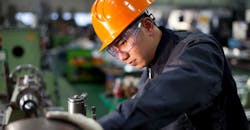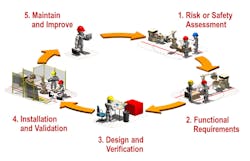Are Your Machine Safety Systems Optimized for Cost and Compliance?
It happens all the time: Machine safety systems are built to the incorrect safety level and create big problems in production.
Under-designed systems that fall short of the required safety level can put workers at risk. They can also generate big expenses from lost production time, worker-compensation costs, and fines. On the other hand, over-designed systems can lead to unnecessarily complex and expensive machines. These machines are more difficult to operate, require more maintenance, may create nuisance trips, and take up more space on the plant floor.
So how do machine designers and users make sure that safety systems are specified, designed, and built to the proper safety level?
The most important thing they can do is follow the Functional Safety Life Cycle to precisely define and meet their safety performance requirements. And as part of this optimization process, they should also be looking for ways to maximize their safety system’s performance to realize additional business value beyond injury reduction or compliance.
The Functional Safety Life Cycle can help avoid problems and determine the level of safety that is required.
Understand the Safety Life Cycle
There’s a recurring theme for why many machine safety systems are built to the incorrect safety level: uncertainty.
Sometimes, end users specify a safety system to the highest possible performance level (PL) because they don’t know what level is actually required. Or, they may request a specific PL in a new machine but don’t know how to verify that the constructed machine actually achieves it. Many machine builders simply don’t know how to correctly identify, realize, or verify the required PL in their offerings.
The Functional Safety Life Cycle can help avoid these problems. It outlines a rigorous, systematic set of processes for assessing, mitigating, and verifying machine-safety systems.
This can help confirm machines are designed and built to the proper safety level. And it can help set clear expectations for what’s required in a machine-safety system for both machine designers and end users.
The Functional Safety Life Cycle is defined in the IEC 61508 standard and involves five steps:
- Risk or safety assessment. Performing an assessment to identify tasks and hazards, estimating the associated risks while outlining mitigations.
- Functional requirements. Defining the safety functional requirements that help mitigate the hazards identified in the assessment.
- Design and verification. Selecting the appropriate safety devices and architecture, along with monitoring and verifying that the system has achieved the required PL defined in the risk assessment.
- Installation and validation. Installing the system and validating that mitigation solutions perform as intended under normal and fault conditions.
- Maintain and improve. Change management to maintain compliance over the life of the machine.
By following these steps, engineers can precisely design and build safety systems to the right safety level while avoiding unnecessary cost and complexity.
Consider a machine end user who has traditionally specified that all safety systems be built to a SIL 3/PLe safety level. If they discover through risk assessment that a new machine only requires a SIL 2/PLd safety level, the cost of the safety system might be reduced by 25% to 40% with a reduction in control panel size of up to 40%. Proper design targets can help right-size engineering and contain system costs.
Machine designers and users can leverage a variety of industry tools to demonstrate system design compliance.
Automated design tools provide a simple, consistent way to design machine safety systems within the safety life cycle. These tools can help engineers select the right safety devices, verify that a safety system meets all requirements, and document the process to help achieve compliance. Pre-engineered safety-function documents can also give engineers guidance for incorporating proven safety functions that include documented functional requirements, equipment bill of materials (BOM), wiring and configuration details, programming examples, and PL verification analysis.
Maximize Safety System Performance
The latest smart, scalable, and high-performing safety technologies can help machine designers right-size safety systems to the required safety level. But the technologies can also help machine users get more value from their safety systems and the machines under control.
For example, consider a presence-sensing safety function like a tripped light curtain that de-energizes a machine. In a conservative calculation, the latest high-performing safety controller on the market could reduce the safety function’s response time by up to 200 milliseconds compared to other controllers in use today. Now, a light curtain can be mounted 12 in. closer to a machine while still achieving the required stopping time.
This can take a full step out of an operator’s task when they move in and out of a machine. That might seem like a minor change, but one small step for an operator can be a giant leap for improving productivity. Specifically, taking a step out of a task can reduce an operator’s cycle time by 0.5 sec. and improve operator utilization by up to 5%. This helps make labor more efficient and lessens the ergonomic load.
A shorter safe stopping distance can also reduce a machine’s footprint. If a light curtain safety function saves 12 in. of floor space and is used at 150 load points in a plant, and each operator load window is 4 feet wide, that adds up to 600 sq. ft. of space savings. This is floor space that can be put to productive use.
Faster and smarter safety technologies are also helping redefine what modern production can look like, and how people and machinery can interact more productively.
New collaborative applications, for example, use safety systems that allow robots and humans to work nearer to each other. The robots are ideal for taking on heavy-lifting and repetitive tasks and can slow down, change course, or come to a stop based on the distance to a human. Smart safety technologies that provide access to safety-system usage data can also help manufacturers better understand risks, enhance safety, improve production efficiencies, reduce safety-related downtime, and improve compliance.
Safety’s Sea Change
Many people in the industrial world still believe that safety improvements degrade production. But safety-system designs, standards, and technologies are all evolving in a way that allows companies to use safety to complement and even improve production.
Machine builders and users are increasingly embracing these changes in thinking and method. Doing so may require a fundamental shift in how safety is viewed—from seeing it as a burdensome requirement to something that can help them meet their business and production goals. But the rewards are worth it: making jobs easier and faster, improving efficiencies, and ultimately creating more competitive and profitable operations.
George Schuster is a TÜV Functional Safety Expert and business development manager at Rockwell Automation. Brad Prosak is a safety commercial engineer at Rockwell Automation.


